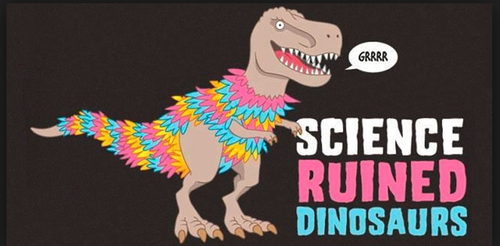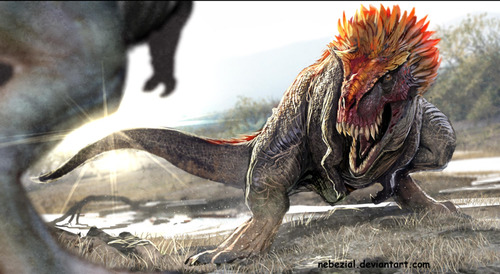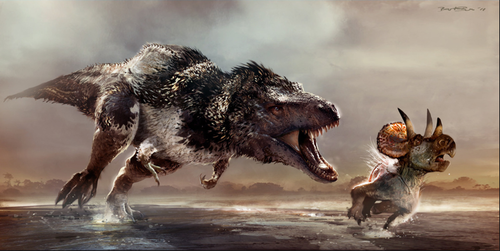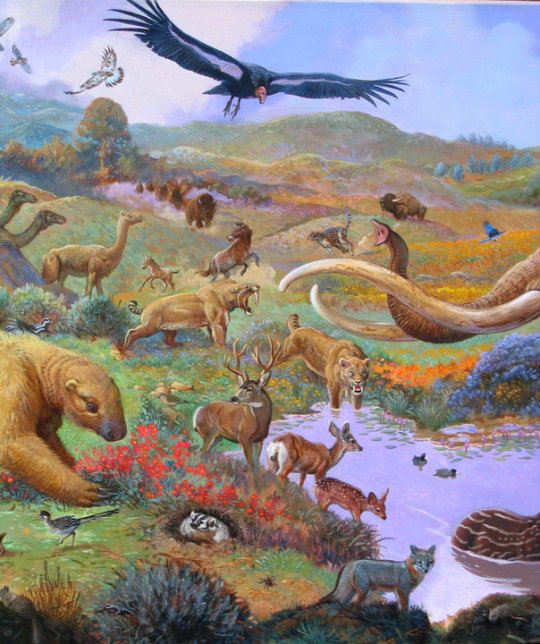Text
Two kinds of people:
People who took the news of feathered dinosaurs like this:

And those who took it like this:


433K notes
·
View notes
Photo

I finished this a while ago but I’m still trying to smoothen out the bottom part of the piece is mildly crinkled before I scan it. #nanuqsaurus #watercolor #art #painting #drawing #paleoart #tyrannosaurid
70 notes
·
View notes
Photo

Deinocheirus photobash by Ville Sinkkonen
278 notes
·
View notes
Video
youtube
Today is so exciting for a ton of fellow palaeontologists, students, researchers, and myself… Dreadnoughtus has finally been published!
The video above gives you guys a bit of history to where this titanosaur was discovered back in 2005. Almost ten years later and it’s finally gone public! With a name like Dreadnoughtus, it’s hard not to want to run around saying its awesome name.
These fossils spent a lot of time being excavated out of the matrix they were found in; around 4 years with multiple labs working tirelessly to clean and repair them. We had to get it done at least in some sort of quick time, right? With such a huge specimen, a lot of man power is required!
I’m so proud and happy for everyone involved that we can now share this gorgeous dinosaur to the public! It’s MASSIVE. The fossils are just mind blowing to look at, and now we continue to move forward with its preservation, education, and further research. It’ll be going back to Argentina next year.
You can read the article about Dreadnoughtus here on Drexel University’s website, and the scientific paper on Nature.com (which some super awesome people I know worked on).
2K notes
·
View notes
Photo





Pleistocene Mural by William Stout for the San Diego Zoo.
Note that only the first picture is finished, the rest are some of the WIPs Mr. Stout posted in his journal (see the link above), where he wrote 30 entries about the making of this mural. The final artwork has this level of detail. Again, check the first link for more pictures and information.
1K notes
·
View notes
Photo

Fifty-million-year-old fossil beetles that fed only on palm seeds are giving Simon Fraser University biologists Bruce Archibald and Rolf Mathewes new information about ancient climates.
According to their research, published online this week in The Proceedings of the National Academy of Sciences, these fossil beetles indicate that during a period of global warming in the geological past, there were mild, frost-free winters extended even in the uplands of ancient western North America.
Working with co-authors Geoffrey Morse of the University of San Diego, California, and David Greenwood of Manitoba's Brandon University, researchers used fossil beetles to determine winter temperatures where they couldn't place a thermometer—in the 50-million-year-old uplands of British Columbia and Washington.
The key to their study was finding a particular group of beetles that only feed on palms.
"The natural distribution of palms is limited today to regions without significant frost days, which their seeds and seedlings can't survive," Archibald explains. "A cooler upland with palms indicates a specific climate type, where a temperate average yearly temperature—rather like Vancouver today—had warmer winters where palms can complete their lifecycles."
But since detecting palm fossils is difficult, the research duo developed a new technique—they used the beetle fossils to test for the palms' presence. Read More.
7 notes
·
View notes
Photo


A team of researchers working at China's Kuanti formation has unearthed the largest known example of a jawed vertebrate from the early Devonian, commonly known as the Silurian period. In their paper published in Scientific Reports, the team describes the predatory fish as being approximately 1 meter long with two types of teeth, one for catching prey, the other for crushing hard shells.
The discovery adds new evidence to the theory that animals with backbones and jaws first developed in what is now China and also disrupts current theories regarding atmospheric oxygen levels during early Earth history. The researchers believe the fish, Big Mouth, Blunt Tooth (Megamastax amblyodus), lived approximately 423 million years ago—a time period that until this new discovery was thought to be characterized by low atmospheric oxygen levels. But a large fish such as Megamastax couldn't survive under such conditions, thus, levels must have been higher.
The find actually consisted of three fossils from three different fish—one a whole lower jaw, the other two, both fragments of an upper jaw—all found at the Yunnan province dig site. The size of the jaw and teeth allowed the researchers to suggest the entire fish, when alive, would have been approximately 1 meter long. The teeth in front were sharp, for grabbing, while those in the back were clearly meant for grinding, likely hard shelled prey. The jaw was approximately 16 cm in length. Read More
1 note
·
View note
Photo

The newly-discovered polar dinosaur Nanuqsaurus, from fossil deposits in Alaska, seen here in scale with a modern-day Inuit girl. Nanuqsaurus was a small-sized relative of the famous Tyrannosaurus rex.
Buy a print of this work at Zazzle.com www.cmkosemen.com
682 notes
·
View notes
Photo


Prehistoric Colors Preserved in Near-Perfect Beetle Fossils
BY BRANDON KEIM
Despite being tens of millions of years old, some beetle fossils appear almost as they did in life. Not only are their shape and structure preserved, but so are the actual colors of their shells, which have changed only slightly in the intervening eons.
Though relatively little-known, these fossils represent the purest of biological colors retrieved from deep time, far richer than much-celebrated pigment traces of dinosaur plumage and more varied than the hues of a few ancient plants.
In a study published Sept. 27 in Proceedings of the Royal Society B, researchers led by Yale University paleogeologist Maria McNamara analyzed 10 of these spectacular beetle fossils, ranging from 15 million to 47 million years old, which owe their enduring shades to the phenomenon of structural coloration. Unlike pigments, which generate color from light bouncing off a chemical, structural colors are produced by the interaction of light with nanometer-scale surface geometries.
Continue Reading
717 notes
·
View notes
Photo



Feathers for Tyrannosaurs
Feathery dinosaurs can be an acquired taste. Not everyone likes seeing animals that have traditionally been wrapped in scales begin to sprout brightly-colored plumage, especially when such changes threaten to dispel the menacing appearance of Hollywood dinosaur villains like Jurassic Park‘sVelociraptor. Of course, alterations to some dinosaurs raise the dander of fossil aficionados more than others. A fluffy Siats will stir debate among experts, but, simply by dint of the dinosaur’s celebrity, the prospect of a fuzzy tyrannosaur is a pop culture flashpoint in the tussle between dinosaurs of our childhood and the animals science is uncovering.
The impending release of Walking With Dinosaurs 3D has put tyrannosaur feathers on my mind again. The Land Before Time it ain’t, but the gorgeously-rendered animated film will undoubtedly excite the latest generation of young dinosaur fans. That’s why many paleontologists and dinosaur fans are disappointed that CGI docudrama’s villains, a gaggle of iridescent Gorgosaurus, are devoid of any fluff or fuzz.
In the grand scheme of the tyrannosaur family tree, Gorgosaurus was a large, sleek, and agile member of a subgroup called tyrannosaurids. This is the category of the most famous tyrant dinosaurs, including Tyrannosaurusitself. Yet we know relatively little about what the outside of these dinosaurs looked like. There are some rumored skin impressions – some lost, others frustratingly unpublished – that show tyrannosaurids had pebbly scales, at the very least. Befitting the traditional view of dinosaurs as scabrous reptiles, the filmmakers decided to go the conservative route and reviveGorgosaurus sans fluff.
Body size has played into the argument for scaly tyrannosaurids, too. If a 30 foot long, two ton plus Gorgosaurus had an active, hot-running metabolism, then wouldn’t an insulating coat of fluff cause the predator to overheat? Scale supporters could concede that small tyrannosaurs, and maybe even tyrannosaurid chicks, had fluff, but the prospect of a heat-addledTyrannosaurus has helped keep large tyrannosaurs scaly.
Enter Yutyrannus. Not long after the Walking With Dinosaurs 3D settled on their scaly Gorgosaurus, paleontologist Xu Xing and colleagues described a roughly 30 foot long, one and a half ton tyrannosauroid that wore an expansive coat of protofeathers. Yutyrannus, along with some experimental work on how large animals shed body heat, suggest that body size was not a barrier to being a fluffy dinosaur.
Yutyrannus was described too late to change the look of Hollywood’s latest take on Gorgosaurus. And fans of the scaly-skinned model are often quick to point out a relational barrier between the two dinosaurs. The 125 million year old Yutyrannus was an archaic from categorized as a tyrannosauroid, while Gorgosaurus was a later and more derived member within the tyrannosaurid subgroup. Since the only tyrannosaurs so far discovered with protofeathers are the tyrannosauroids Yutyrannus and the comparatively tiny Dilong, and tyrannosaurids only left behind scaly skin, then maybe tyrannosaurs shed their simple plumage over evolutionary time.
Read More
613 notes
·
View notes
Photo

The King of Gore Lythronax argestes (lythron meaning “gore” and anax meaning “king”) by Zubin Erik Dutta
382 notes
·
View notes
Photo








Geosternbergia sternbergi (formerly Pteranodon) series, by Tuomas Koivurinne
502 notes
·
View notes
Photo

Picture: The mesocyon, the earliest tracked achestor of the wolves
ORIGIN OF THE WOLF
The earliest fossil carnivores that are certain to be the anchestor of today’s canids are the Eocene Miacids that lived 38-56 million years ago. There were two lines that evolved from the miacids – the feloidea (lions, cats, caracals) and the canoidea (wolves, dogs, foxes). The canoid line evolved from the Mesocyon that lived approximately 35 million years ago. It was the same size as today’s coyotes, and is believed to have lived in packs just like wolves do today. The line evolved further with (among others) the fox-like Leptocyon and the wolf-like Eukyon that wandered North America some 10 million years ago.
308 notes
·
View notes
Photo

Anomalocaris feasting on a Paradoxides trilobite
314 notes
·
View notes
Photo

Baryonyx & Hypsilophodon, Miguel Ángel Amorín Fernández, 2013
The cool mud felt good between the little dinosaur’stoes. The pod came here to drink and nibble on weeds. They communed through pips and nods, confirming hierarchies and reinforcing connections. The muddy bank, the sound of the river, the emeralds and ceruleans of the forest all built layers of calm for the Hypsilophodonts. They were a nervous breed, but liked to be soothed.
A monitor whistled five quick notes, and the peace was gone. As the pod started to scamper, a Baryonyx shuffled from the green. Its long head swung slowly, obsidian eyes monitoring the frightened movement. Hypsilophodon, feet still in the cool mud, stood while the others panicked, watching the massive thing lumber through the hopping pod. It was big, silent—its motions methodical and confident; the pod was the opposite—small, squeaky, consumed by fear-born chaos. The Baryonyx looked towards the Hypsilophodon and the little dinosaur’s heart jumped. Within a second, it too had ducked into the woods, leaving behind only rustling leaves and footprints in the mud.
307 notes
·
View notes
Photo

Euphanerops, a fossil jawless fish has been found to have paired anal fins. Previously paired fins were thought to be a trait only found in jawed fishes, but the paired anal fin of Euphanerops is particularly unique as jawed fishes have only been known to have unpaired anal fins. According to Dr. Samsom, "The unusual paired anal fin of Euphanerops lends support to the idea that there was some degree of developmental and evolutionary experimentation in some fish. After the Devonian period and the extinction of a lot of species, the jawed vertebrate body exhibits fewer deviations from the formula of paired pectoral, paired pelvic, unpaired dorsal and unpaired anal appendages. The discovery of new anatomical conditions will hopefully shed more light on the timing and sequence of the events underlying the origin and diversification of vertebrate appendages."
Read the full story here.
1 note
·
View note



